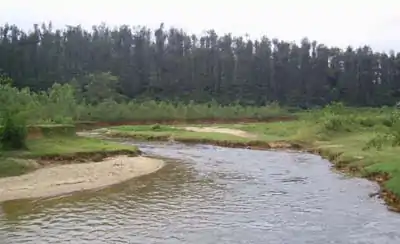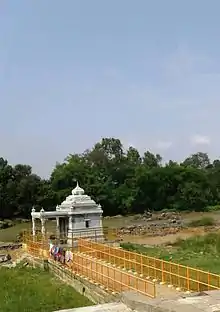Hemavati River
The Hemavati is a river in Karnataka, southern India,[1] an important tributary of the Kaveri.



Origin and course
The Hemavati River starts in the Western Ghats at an elevation of about 1,219 metres[2] near Balur in Mudigere taluk of Chikmagalur District of the state of Karnataka, in southern India. It flows through Hassan District where it is joined by its chief tributary, the Yagachi River, and then into Mandya district before joining the Kaveri near Krishnarajasagara. It is approximately 245 km long and has a drainage area of about 5,410 km².[3]
Hemavati Dam and Reservoir
A dam across the Hemavati was completed in 1979, above Gorur in Hassan district, and downstream from the Yagachi confluence. The dam is a masonry dam with central spillway through 6 radial gates. It is 44.5 meters in height, and 4692 meters long, impounding a reservoir of 9162 hectares. The reservoir has a live storage capacity of 35.7 TMC. [4]
The Shettihalli Rosary Church, which was submerged during the construction of the dam can be seen only when the dam height is low during the summer months. The church was constructed by French Missionaries in the 1860s, and has a mighty and magnificent structure in the Gothic Architecture. In 1960, when the government decided to build the dam, the church was abandoned. When the water level is low, sometimes coracles are used to go inside the church.[5][6]
Footnotes
- Hemāvati River (Approved) at GEOnet Names Server, United States National Geospatial-Intelligence Agency
- "Main Rivers of Karnataka". Karnatakavision.com. Retrieved 5 October 2006.
- "Hemavati River". www.india9.com. Retrieved 5 October 2006.
- http://waterresources.kar.nic.in/salient_features_hemavathy.htm
- "Rising out of the waters" (Bangalore). Deccan Herald. 13 October 2014. Retrieved 16 January 2015.
- Singh, Gurdyal (2013). "Rosary Church at Shettihalli (emerges and submerges)". National Geographic Traveller. Retrieved 16 January 2015.